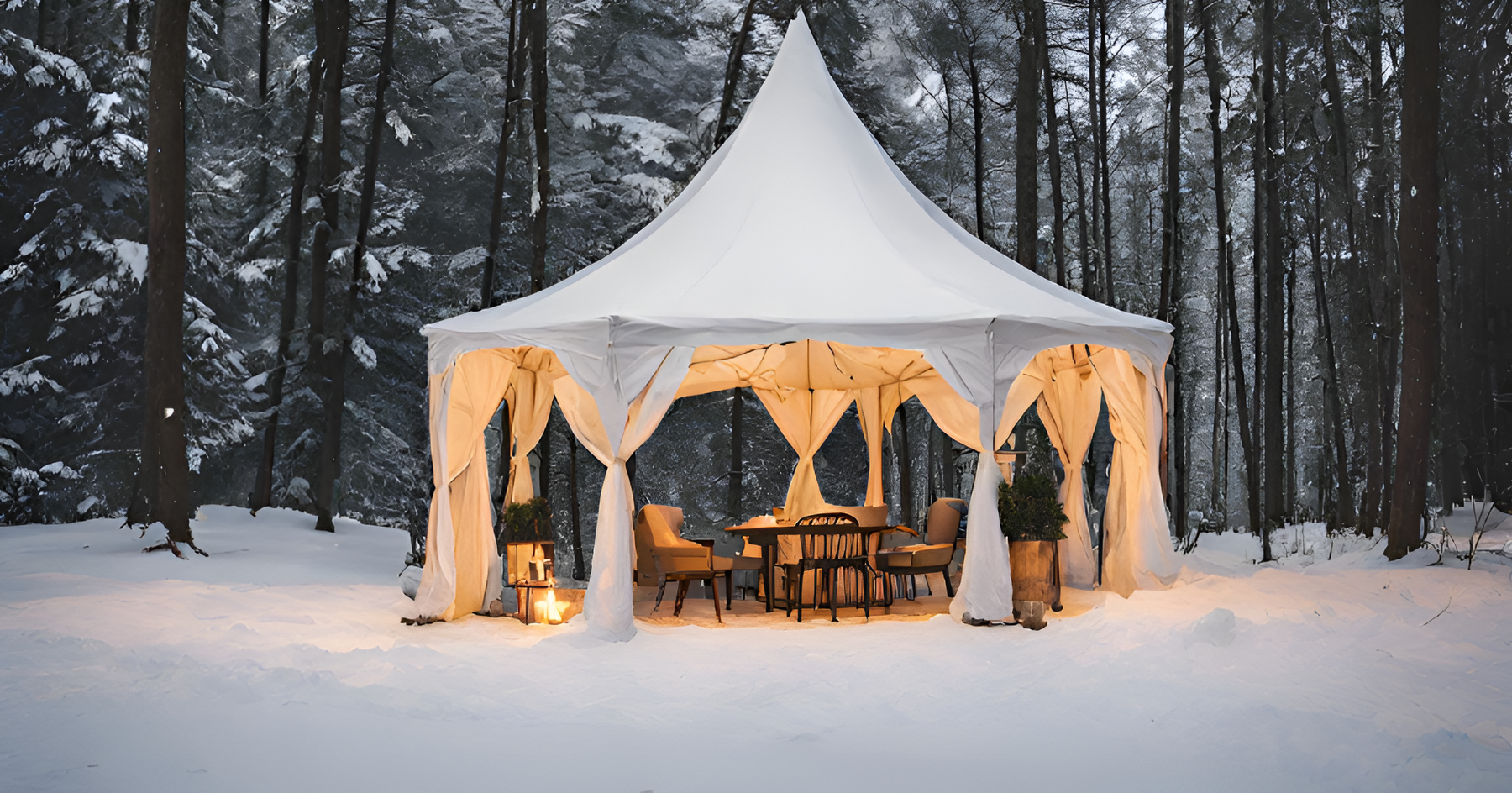
Will Gazebos Hold Up in Snow? Find Out Here!
When winter arrives and the snow starts falling, many outdoor enthusiasts wonder if their beloved gazebos can withstand the harsh weather conditions. After all, gazebos are not only a beautiful addition to any garden or patio, but they also provide a cosy retreat to enjoy the outdoors. In this article, we will explore the snow resistance of gazebos and discuss their snow load capacity and durability in winter conditions.
Key Takeaways:
- Gazebos can withstand snow if they have sufficient snow load capacity.
- Snow load capacity refers to the amount of weight a gazebo can bear before it becomes structurally compromised.
- Proper maintenance and snow removal techniques are essential to ensure the longevity and snow resistance of gazebos.
- Choosing a snow-friendly gazebo with sturdy construction and materials is crucial for withstanding heavy snowfall.
- Winter-proofing your gazebo includes additional measures such as using protective covers and reinforcing weak spots.

Understanding Snow Load Capacity of Gazebos
When it comes to selecting a gazebo for your outdoor space, considering the snow load capacity is of utmost importance. Snow load capacity refers to the amount of weight that a gazebo can safely withstand from accumulated snowfall.
But what does snow load capacity really mean? It is the maximum weight or pressure that snow exerts on a structure. This calculation takes into account factors such as the density of the snow, the pitch of the roof, and the overall design and materials used in the construction of the gazebo. By ensuring that your gazebo has a sufficient snow load capacity, you can safeguard against the potential collapse or damage caused by heavy snow loads during winter.
So, how is the snow load capacity of gazebos calculated? It involves considering various factors, including the location of your gazebo, the average snowfall in your region, and the specific design and structural characteristics of the gazebo itself. These calculations are typically done by qualified engineers or structural professionals, who take into account industry standards and local building codes.
Having a gazebo with adequate snow load capacity is crucial, especially if you live in an area with heavy snowfall or where winters can be particularly harsh. Snow-resistant outdoor structures, such as gazebos, are built to withstand these challenging weather conditions and keep your outdoor space safe and functional.
The Importance of Snow-Safe Gazebos
Investing in a snow-safe gazebo offers peace of mind and ensures that you can enjoy your outdoor space even during the snowy months. Snow load capacity not only protects your gazebo from structural damage but also safeguards the safety of those who use it.
- A gazebo with sufficient snow load capacity will prevent any risk of collapse or structural failure under heavy snow accumulation.
- By choosing a snow-resistant gazebo, you can confidently embrace the winter season and create a cozy retreat outdoors without worrying about the effects of snow on your structure.
- Additionally, snow-safe gazebos are designed to withstand the expansion and contraction caused by fluctuating temperatures, offering increased durability and longevity.
In summary, understanding the snow load capacity of gazebos is crucial when selecting a structure that can withstand the challenges of winter weather. By choosing snow-resistant outdoor structures like gazebos, you can create a safe and functional space that withstands heavy snow loads and provides enjoyment throughout the year.

Tips for Ensuring Snow-Safe Gazebos
Winter can be a challenging time for gazebos, but with proper maintenance and proactive steps, you can ensure that your gazebo remains sturdy and snow-safe throughout the season. Here are some essential tips to help you winter-proof your gazebo:
- Regular Inspections: Conduct regular inspections of your gazebo to identify any signs of damage or wear. Look for cracks, loose screws, or weakened structural elements. Promptly address any issues to prevent further damage during snowfall.
- Reinforce the Roof: The roof is most vulnerable to heavy snow loads. Strengthen the roof structure by adding additional supports or reinforcing beams. This will help distribute the weight of snow more evenly and reduce the risk of collapse.
- Snow Removal: It's essential to remove snow from your gazebo to prevent excessive weight build-up. Use a soft-bristle broom or snow rake to carefully remove snow from the roof and the sides. Avoid using sharp tools or excessive force, as they can damage the gazebo.
- Protective Covers: Consider using winter-proof gazebo covers or tarps to provide an added layer of protection during heavy snowfall. These covers can prevent snow accumulation and minimize exposure to harsh weather conditions.
- Winterizing Sealants: Apply winterizing sealants or protective coatings to the wooden surfaces of your gazebo. These sealants can help repel moisture and prevent wood rot, extending the lifespan of your gazebo.
- Snow Clearance Around the Gazebo: Clear snow from around the gazebo to minimize the risk of snow drifts. These drifts can put additional pressure on the gazebo's walls and weaken its structure. Clearing the surrounding area will help maintain the stability of the gazebo.
By implementing these tips, you can create a snow-friendly environment for your gazebo and ensure its longevity. Remember, proper maintenance, snow removal, and protective measures are key to maintaining a winter-proof gazebo that can withstand the challenges of heavy snowfall.

Conclusion
In conclusion, when it comes to withstanding snow, selecting a gazebo with adequate snow resistance is essential. As we've discussed in this article, the snow load capacity of gazebos is a crucial factor to consider. A gazebo's ability to hold up under heavy snowfall and freezing temperatures depends on its design, materials, and construction.
By choosing a snow-resistant gazebo, you can create a sturdy and durable outdoor retreat that can withstand harsh winter conditions. Regular maintenance, such as clearing snow from the roof and maintaining the structure, is also key to ensuring its longevity and snow-friendly capabilities.
So, can gazebos withstand snow? With the right precautions and proper care, snow-resistant gazebos can indeed brave the winter elements. Whether for hosting winter gatherings, enjoying cozy moments, or simply embracing the beauty of a snowy landscape, a well-chosen gazebo can be your snow-safe haven.
Other content you'll love:
Are Gazebos Waterproof? A Guide to Outdoor Shelters
Winter-Proofing Gazebos: Can They Stay Outside?
Relocating Your Gazebo? Can Gazebo Be Moved Tips
Mounting a Gazebo on Concrete: Is It Doable?
Installing a Gazebo on Grass: Is It Possible?
Gazebos and Lightning Safety: What You Need to Know
Gazebo Weights Reviewed: Are They Worth It?
Gazebo Tents: Good Choice for Outdoor Events?
Easy Gazebo Setup Guide: Are Gazebos Easy to Put Up?
Can Gazebos Go on Decking? Essential Tips & Ideas
Attaching a Gazebo to Your Home? Learn How!
Are Gazebos Safe in Wind? Stability Tips & Tricks
Are Gazebos Permanent Structures? Find Out Now!
Are Gazebo Covers Interchangeable? Find Out Here!


